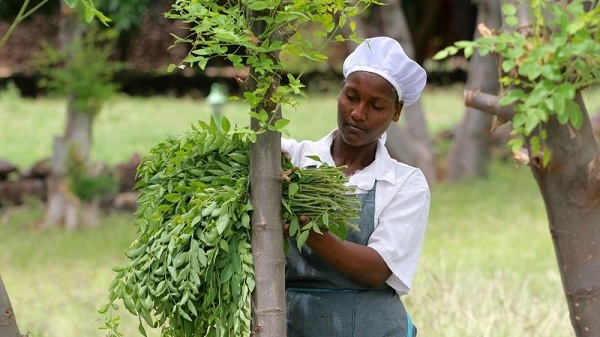
MESQAN WOREDA, Ethiopia (The Hunger Project) – In the Mesqan region of Ethiopia’s highlands, The Hunger Project works hard to promote Moringa, the miracle tree. Moringa leaves contain many vitamins and minerals and they hugely enhance the nutritional value of a daily meal. This can be highly beneficial, especially for pregnant women, new mothers and young children. Older children can also hugely benefit from it. This is how it works in Ayelech Ebsa’s family
Ayelech’s house is tucked away between the fields and a false banana plantation, far away from the highway. False bananas are banana trees that don’t bear fruit. The trunk of this tree is a favorite food in this area. Ayelech lives with her husband and her five children, whose ages vary between 4 and 14 years. Her husband is a truck loader and is often on the go. In order to earn some extra money, she distils alcohol.
Ayelech: “My favorite food is, what else, false banana. I have enough trees on my land to cook with it every day. I don’t grow vegetables, and I can only buy them when I have enough money.”
Ayelech had never heard about Moringa. “My youngest children go to preschool at the Mesqan epicenter. They told me about a cooking demonstration of The Hunger Project. That triggered me!
Before that, I had no idea, but now that I know about the nutritional value of Moringa, I think it can be a good addition to our daily meals. They said that Moringa is very rich in calcium, vitamins, proteins and much more.” Her 4-year-old Mekedelawit adds: “I love vegetables like tomato and spinach, but my mother doesn’t cook that very often. I tasted the Moringa porridge and loved it! I wish that my mum could make it more often.”
In the lowlands of Ethiopia, Moringa is a native plant and the people there eat it daily. In the highlands, it’s a completely different story. Moringa is not native there. In 2015, The Hunger Project distributed 3500 Moringa tree seedlings in the Mesqan epicenter and trained thirty volunteers who now know about the high nutritional value of the tree, how to grow a Moringa seedling and how to cook Moringa dishes. These volunteers share their knowledge with the villagers, and they manage the shared Moringa plantation. In March 2016, 15,000 Moringa seeds were grown into seedlings in the government nursery. In June these 15,000 seedlings were distributed so that they can be planted just before the start of the rainy season.
Ayelech: “I really hope I will get a seedling. I want to plant it on my land so that I can cook with it too. All my five children go to school and I encourage them the best I can. It’s at least half an hour’s walk to get there, but they do that gladly. My 10-year old son Samuel wants to become a doctor and my 11-year old son Leul an engineer. Perhaps Moringa will give them more energy, so that the walk to the school will be easier. I will definitely give it to them every day!”
About The Hunger Project
The Hunger Project is a global, strategic organization committed to the sustainable end of world hunger. Headquartered in the New York City, NY, The Hunger Project seeks to end hunger and poverty by empowering people to lead lives of self-reliance, meet their own basic needs and build better futures for their children.
Source: The Hunger Project
